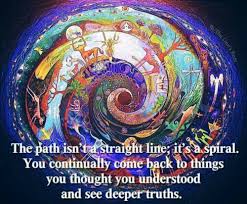 The human experience is dynamic. There are continual demands on our day to day living. Our kinetic lives, this continual movement, is central to the kinetic aspect of Patera Kori Studios spiral arm sculptures.
The human experience is dynamic. There are continual demands on our day to day living. Our kinetic lives, this continual movement, is central to the kinetic aspect of Patera Kori Studios spiral arm sculptures.
A spiral can be presented as a symbol of growth and development but it is primarily a symbol of change and progression. However, the outcome of the change is not certain and the direction of the progression is not necessarily positive. But what is most certain is that the rotating spiral arm is not still and, likewise in our lives, we are not “stuck” in one place. Psychologists use the spiral as a tool to demonstrate the possibility of change and moving beyond the current situation. Where we are is just the starting point of where we are going. And as we move along the spiral path of our lives, we see there exists an opportunity for renewal and new beginnings. Hopefully, we conduct ourselves to move in a positive, constructive, helpful, empathetic direction. Our lives can be a continual transition of growth and expanded knowledge and wisdom.
Spirals and Balance
We also need another important component in our lives and that is balance. You will notice that the spiral arm of a Patera Kori Studios sculpture is precisely balanced on a single point that is the center axis of the sculpture. The psychologist advises that the search for balance in our daily lives is often elusive and difficult to achieve but it is an absolute necessity. If unbalanced, the sculpture and our lives would wobble, swing back and forth, oscillate side to side. The result would be haphazard and disruptive and not harmonious and aesthetically pleasing.
Anne Marrow Lindbergh, in her book “Gifts From The Sea”, relates different sea shells she finds washed up on the beach on Florida’s Sanibel Island, to different times in a women’s life. She writes about the need to “still the soul” within all the swirling obligations of relationships, activities and responsibilities. Ms. Lindbergh advises that we try to achieve a position that is like being at the center of a spinning top. The revolving spiral of a Patera Kori Studios sculpture, like the revolving spiral of our lives or a spinning top, requires a still, balanced center axis.
Spirals and Pace
The spiral can also remind us to slow down. Our lives often seem to be moving at a frantic and sometimes chaotic pace. The meditative and contemplative slow motion of the revolving spiral has a calming physiological effect. Studies have shown that external influences and design elements can have a profound effect on physiological factors such as blood pressure and heart rate. Watching the slowly revolving spiral arm reminds us of watching endless waves rolling onto a gently sloping beach or the flickering flames as we sit around a nighttime campfire.
Psychologically, we can learn a great deal from the making of the sculpture itself. Unlike the immediate results that can be obtained by the bending and twisting of metal into a sculptural shape, wood requires a slower, more patient approach. Wood must be gently and continually adjusted to achieve the artist’s vision of the completed work. Going too far or too fast will likely snap the wood. The splintered wood is a reminder that gentle effort, continually applied, like water flowing downstream, is often what is needed to achieve the desired result in our sculptures and in our lives.
Quote – www.pinterest.com
